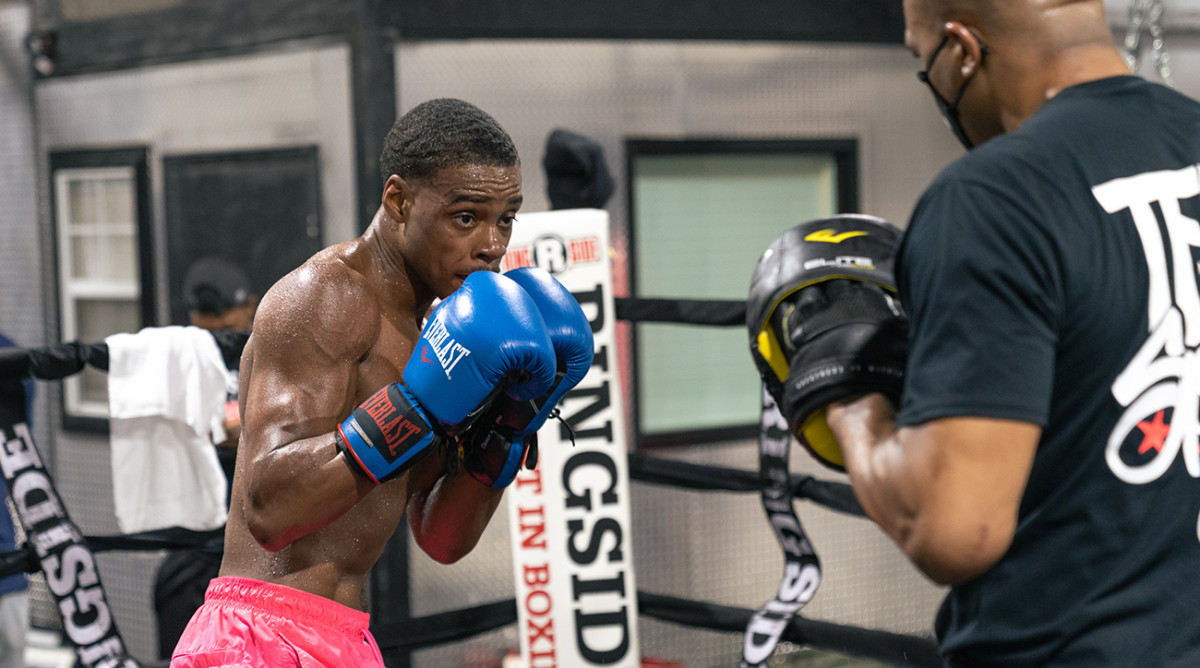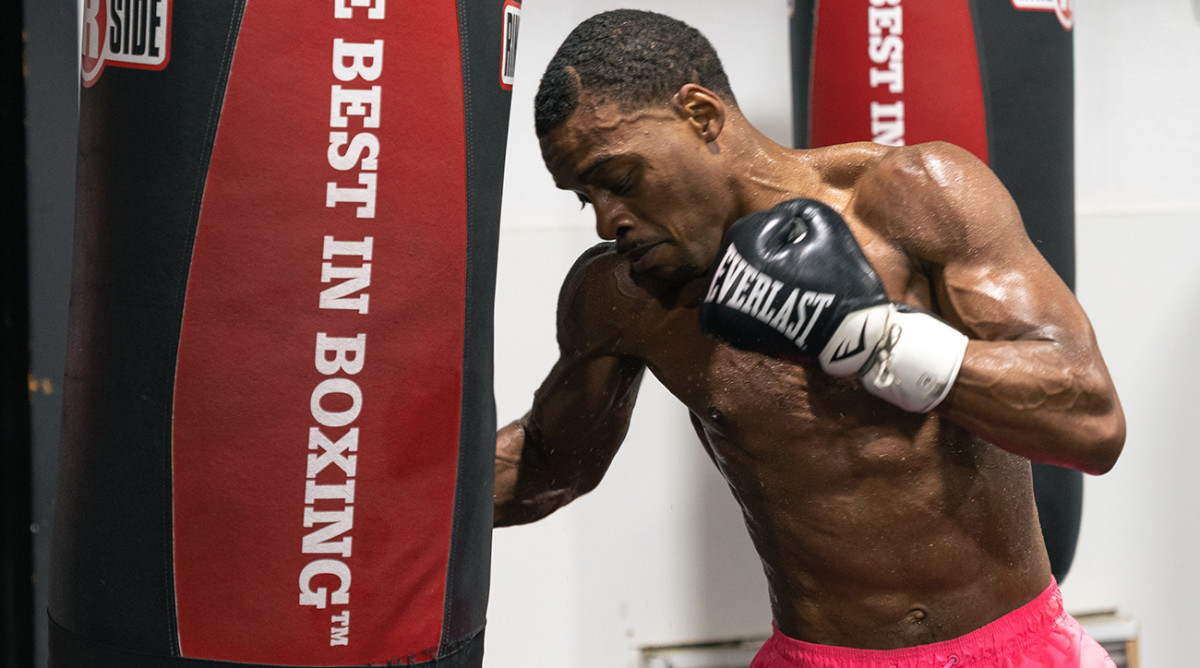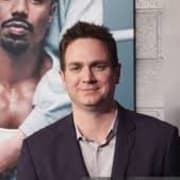Ahead of Return to the Ring, Errol Spence Jr. Isn't Taking His 'Second Chance' for Granted


The wreckage of the white Ferrari skidded to a stop on the 500 block of South Riverfront Boulevard in Dallas, a half dozen flips turning the six-figure sports car into a mangled pile of smoldering metal. The driver, Errol Spence Jr., boxing’s unified welterweight champion, wasn’t in it. He had been ejected through the windshield during the crash, landing face first on the pavement some 40 feet away. Footage was captured by a security camera at Knockout, a sports bar that regularly showed Spence’s fights.
Errol Spence Sr.’s phone rang just after 2 a.m. that October night, the voice on the other end shaking as it delivered the news. EJ’s been in a car accident, one of Junior’s friends said. You have to come to the hospital. The hospital? Spence had just seen his son hours earlier. Junior had taken his Dad to the store for a new cellphone. He brought his two daughters, Violet and Ivy, along with him. He had even worked out, going for a run before heading to meet some friends a little before 10. Now, Senior was told, he needed to get to Methodist Dallas Medical Center. His son could be fighting for his life.
On the ride to the hospital, Errol Sr.’s mind raced. Senior feared for his son, as any father would. A 2012 U.S. Olympian, Spence turned pro shortly after the London Games. At 5’ 10” and a sturdy 147 pounds, Spence had all the physical tools. He aligned himself with Al Haymon, a powerful adviser. He won his first title in 2017, traveling to England to knock out the more experienced Kell Brook. He unified the titles in 2019, outpointing Shawn Porter. Along the way, Spence established himself as a pay-per-view attraction. He was a star. Senior didn’t worry about a high-speed crash as much as an envious onlooker sticking a gun in his son’s face.
Boxing made Spence wealthy, and Senior appreciated that. But he had begun to hate the sport. It was Senior who pushed Spence into boxing, his way of getting a feisty teenager off the streets. Born in Jamaica, Senior moved to New York in 1973, part of a nine-child family seeking a better life. Two decades later and with a family of his own, Senior packed up and moved to Texas, landing a job as a contractor with FedEx. One day, he spotted his son shadowboxing outside. He asked one of his friends: Can EJ fight? Spence, the friend said, had developed something of a reputation as a fearsome street brawler. A few days later, Senior took his son to a boxing gym.
Senior enjoyed his son’s rise. But in recent years the fights were getting tougher, more physical. Brook got his licks in. Porter was a war. The violence, Senior says, scared him. “I think with each fight, a boxer loses something,” says Senior. “That's the part about it that's troubling to me. Sometimes it's like, What did I do getting him into this? Did I do the right thing?” He feared one day having to visit his son in the hospital—though not for this reason.
A crowd of friends and family had gathered in the waiting room when Senior arrived. He didn’t know the details of his son’s injuries. “I hoped maybe he was a little banged up, a little bruised,” says Senior. It was worse. Spence was in intensive care, drifting in and out of consciousness. Machines monitored his vitals. A nurse asked if Senior wanted to see him. Senior declined. “I couldn’t see him like that,” says Senior. “I couldn’t go in the room.”
He spent the night in the waiting area, getting updates from the family. The next morning, doctors summoned the two into an empty room. A police officer was there. A chaplain, too. Senior feared the worst. “It felt like someone cut open my stomach,” says Senior, “and stuck a bowling ball in there.” The news was good, though. No internal injuries. No broken bones. Just a bruised knee, a twisted ankle, some deep lacerations and a few broken teeth. “It’s almost impossible to have that kind of crash and only come out of it with those injuries,” says Senior. “Someone was looking out for him.”
Hours later, Senior’s daughter, Ebony, emerged from the hospital room. EJ is awake, she said, and he’s asking for you. Senior went in. He saw his son with tubes in his nose and an IV in his arm. His right eye was closed. Bruises covered his face. Tears welled in Senior’s eyes. Suddenly, the bowling ball feeling returned. “I wish there was a better way to describe it,” says Senior. “I hope I never feel it again.”
Nearly 14 months have passed since the crash. Spence has not only recovered, but is ready to resume his career. On Saturday, Spence will return against Danny García, a dangerous, two-division titleholder who will face Spence at AT&T Stadium in Arlington, Texas. Before the accident Spence, 30, was peaking, rocketing up pound-for-pound lists, establishing himself as one of boxing’s most bankable stars. A win over García would return him to that track. But while Spence’s life was spared last October, many have wondered: As a boxer, will he ever be the same?
***
Errol Spence Jr. wasn’t a boxing prodigy. He was 15 when his father brought him to Gene Vivero’s gym, one of two black faces in a crowd thick with aspiring Mexican boxers. He had been a football player to that point, accustomed to wind sprints, not three-mile runs; familiar with helmet-to-helmet collisions, not the searing pain of a body shot. His first sparring session, Spence, then 141 pounds, stepped in with a 118-pounder. Easy work, thought Spence. He came out of the corner winging punches. After 30 seconds, Spence began to tire. His smaller opponents slipped to the inside and hammered him to the liver. Down he went. “I got up and kept fighting,” Spence insisted. “But it was a whole new experience.”
Spence took to boxing quickly, spending the next four years racking up wins in amateur tournaments. But something was missing. Spence Sr. couldn’t put his finger on it. His son loved boxing, especially Lennox Lewis, whose family roots are Jamaican. He just didn’t know boxing.
Derrick James did. In 2008, James, a journeyman super middleweight, was at the end of his career. He had sparred with Spence, a smaller, quicker fighter who helped James polish his defense. One day, James spotted Spence at a Silver Gloves tournament. He noted the talent. He also saw the mistakes. “It was double jab, left, double jab, left, over and over,” says James. “He was predictable.” Senior was in the stands. James approached him. He pointed out what Spence was doing. He pantomimed what he thought would be more effective punches. Says Senior, “Everything he said made sense.”
Senior wanted Spence to work with James. But there was a problem. Vivero, says James, didn’t want any help. If you don’t like the way I’m training him, Vivero said, you can take him somewhere else. “With Gene, he wasn’t growing, he wasn’t progressing,” says Senior. “He needed something more.”
James was it. But there was another problem. Spence didn’t want to work with him. “I think he was just comfortable with his other trainer,” says James. “He was comfortable with what he was doing.” Still, Senior insisted. He offered Spence an incentive: $30 a week. He would drive his son to a nearby gym, where James worked as a personal trainer. Spence would get some money out of it. “I think I paid him for like a couple of months,” says Senior, laughing. “I used to pay him and then after his workout, I would just buy him whatever he wants to eat. He liked that kind of stuff.”
James and Spence clicked. “He’s a phenomenal student,” says James. James perfected Spence’s balance. “Before, he was basically a one-two fighter,” says Errol Sr. “He would throw the left and fall in. And if an opponent moved out of the way, he would pretty much fall over the rope.” James discouraged Spence from worrying about combinations. “We don't practice combinations,” says James. “We don't do combinations. We do one shot at a time. And he's very present. I love that about him.”
Success soon followed. Spence stopped 10 of his first 12 opponents. He stopped Chris Algieri in 2016. He knocked out Leonard Bundu, a tough former title challenger, a few months later. That fight, thanks to USA Basketball’s gold-medal-winning game lead-in, was watched by nearly five million viewers on NBC. A year later he went to England, to face Brook. Brook was effective early, seemingly validating concerns that it was too much, too soon. Walk him down, James said after the first round. Spence did, and in the second half of the fight, took over, dropping Brook in the 10th and stopping him in the 11th. “He logs every one of your moves, like a computer,” says James. “He's throwing one punch at a time. He is computing how your body is reacting to each one of the punches. And he's seeing the opening that fast.”
In 2019, Spence beat Mikey Garcia, a then undefeated 140-pound champion. Many observers expected the bigger Spence to bully Garcia. Instead, he outboxed him. Six months later, Spence won a brawl with Porter. A fight against Danny García was in the works. A showdown with Terence Crawford, one of boxing’s top pound-for-pound fighters, seemed imminent. A superstar was being born.
***
Spence can’t remember the accident. “Nothing,” says Spence. He can’t remember the six days spent in the hospital. Or the trip to the police station, where Spence was charged with driving while intoxicated, a mug shot revealing the extent of his facial injuries beamed around the world. His memory crystalizes later, he says, days later, in his downtown Dallas condo, his body aching all over. “I was so sore,” says Spence. “It was worse than sore. I was in pain. I was so hurt, I was like, Man, take me back to the hospital so I can get some more drugs. Everything just hurt.”
Around Spence, no one talked boxing. “I never thought about it,” says Senior. Says James, “I didn’t care about it.” Boxing, though, was all Spence could think about. He wondered if he would ever box again. And if he did, would he be great again? “I just kept thinking, Man, I really messed up,” says Spence. “My career was just starting to get good. And this might be it. I had a lot of self-doubt that I didn't let anybody else really know about. I didn’t tell anybody about it. But it was in my head.”
As his body healed, Spence started to test it. He took the stairs in his condo, walking up 24 flights. “That was a workout,” says Spence. A few weeks later, it was jogs on the treadmill. Then a few miles outdoors. Then shadowboxing. “He didn’t tell me he was working out,” says James. “But when I saw him, he was in a lot of pain.”
Two months after the accident, Spence went back to the gym. The pain was still there. Shoulders, hips, neck. Some days, it was agonizing. “But I needed to see where I was at,” says Spence. “I already knew where I was at mentally with it. If I could still fight, I was going to fight. But I needed to see if my body could do it.”
James eased him back. “We put tricycles on it,” says James. At first, it was punches in the ring. Then 10 minutes on the mitts. Then a few rounds on the heavy bag. Some days were encouraging. Others, says Spence, it was “forget this, I’m done.”
Last December, Spence made his first public appearance, sitting ringside to watch Jermell Charlo, his stablemate, regain a 154-pound title with a knockout of Tony Harrison. Two months later he was in Las Vegas, watching Tyson Fury’s win over Deontay Wilder. The workouts continued. His body felt better. His skills were coming back. Social media, routinely a cesspool of negativity, became a source of motivation. Spence would scroll through Instagram and Twitter, spotting negative comments, screen grabbing them onto his phone. “It really helped me, more than people telling me, ‘You can do it’ or ‘You're going to do this, you're going to do that,’” says Spence. The people telling me I couldn't do it, that I won't be ready, that I won’t come back as the same guy. I just decided I was going to show them.”
Last summer, it was official: Spence would return. But there was one more hurdle: Spence had yet to spar. The damage to Spence’s mouth was extensive. His teeth required significant repair. He estimates he’s had at least six procedures on his teeth, with more to come. “One time they numbed my mouth, man, my nose was numb, everything was numb for a day,” says Spence. “I told them they weren’t numbing me up anymore.”
The first sparring session came in early October, and James admits—he was anxious. “It's like a seat that you sat in for years and you've been out of it and other people been sitting in it,” says James. “When you get back in it takes you time to get comfortable and get the feel of it.” The first session was uneventful. James was happy. The next day, Spence dominated. “He was amazing,” says James. The power was there. Speed, too. He didn’t flinch at incoming punches, instead furiously firing back. When the day was over, James wondered if he would have to give the sparring partners a bonus for hanging in with him. “I have no concerns about Errol,” says James. “He’s answered every question I had.”

It’s late November, and Spence is sitting in front of a fight banner, a towel around his neck, sweat dripping from his face. He’s wrapping up a satellite tour to promote his fight with García, a series of perfunctory 10-minute interviews, each with similar topics. He talks about the accident, broadly. “I feel great,” says Spence. He talks about García. “He’s a dangerous fighter,” Spence said. He responds to comments from Crawford, who had defended his title just a week earlier. “He’s a great fighter,” says Spence. “He knows I want that fight.”
It felt normal. But it’s decidedly not. A shroud of uncertainty engulfs Spence. It’s one thing to look sharp in sparring. It’s another to do it against a top opponent. It would have been perfectly reasonable for Spence to return against a lesser fighter, to test his body before facing stiffer competition. Instead, he went straight for García, a thudding puncher whose two losses to Porter and Keith Thurman came by the slimmest of margins. “I didn't want any tune-up fights,” Spence said. “I wanted someone who is tough and who could push me to the limit, so I can get back to being Errol Spence Jr. I picked Danny so that I could rise to the occasion.”
Spence is confident. That hasn’t changed. But other things have, friends and family say. He’s shed some of the hangers on, tightening his circle. “A lot of them, they were just enablers,” says Spence Sr. “They just wanted to be in the spotlight.” He’s been more committed in training, James says, especially with conditioning. “He’s on weight,” says James. “Normally he would wait until the morning of the weigh-in to get there. He’s shown a lot more tenacity in this camp.”
Spence feels different. It took him two months to watch the video of the crash. “Crazy,” says Spence, his voice lowering. “I should be paralyzed.” His 5- and 3-year-old daughters are aware of the accident, even if they don’t fully understand it. “I will talk to them about my teeth and they’ll say, ‘Why Daddy, because you flew out of that car?’” says Spence. He likens how he feels to that of a cancer survivor. “It makes you realize,” says Spence, “that you are not indestructible.”
He sees life differently now. He’s still driven to be the best, still targeting world titles, still eager for a showdown with Crawford, a welterweight clash that ranks among the best fights in boxing. He still wants to fight. He just appreciates more everything that comes with it. “The time I spend with my family, with my kids, it’s more precious than ever,” says Spence. “You see stuff on the news all the time and you think, ‘That can’t happen to me.’ Well that did happen to me. I almost lost everything. Now I have a second chance. I won’t take it for granted.”
